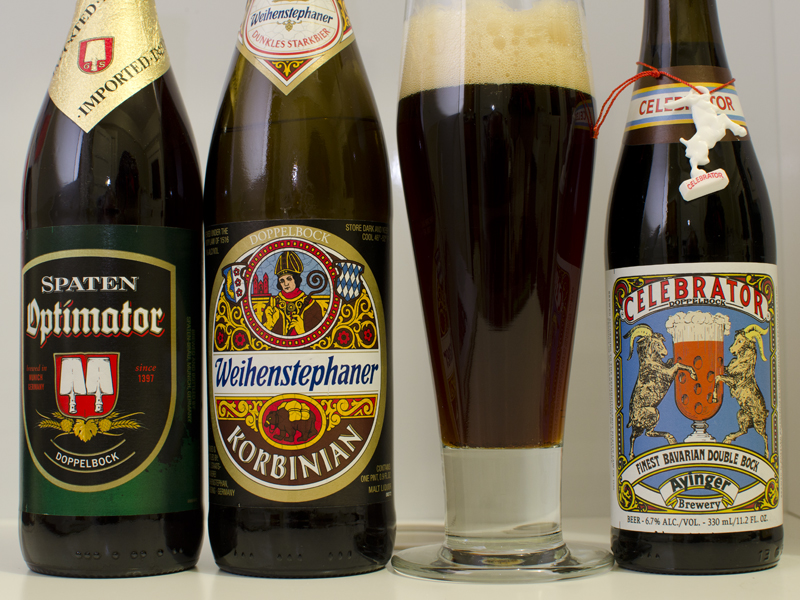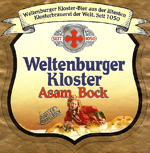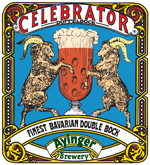The Elegant Doppelbock
 Traditional beer styles are often closely identified by cities, regions, strength or particular moment of invention. Doppelbock (double bock) can claim all of those. Its roots lie in the North German city of Einbeck, but is now synonymous with Bavaria. More specifically, the prototype is a monastic creation, designed for sustenance during Lenten deprivation. The pious origins of the style have largely given way to secular interests and customs, but there is still something reverential about doppelbock. For some of us, it was an enlightening brew discovered well before the advent of microbrews and extreme beers.
Traditional beer styles are often closely identified by cities, regions, strength or particular moment of invention. Doppelbock (double bock) can claim all of those. Its roots lie in the North German city of Einbeck, but is now synonymous with Bavaria. More specifically, the prototype is a monastic creation, designed for sustenance during Lenten deprivation. The pious origins of the style have largely given way to secular interests and customs, but there is still something reverential about doppelbock. For some of us, it was an enlightening brew discovered well before the advent of microbrews and extreme beers.
Discussion about bock begins in Einbeck, whose motto is, “Without our town, there’d be no Bock Beer.” The original brews of the city were known as Einbecker beer, not bock. They were strong, top-fermented, hoppy wheat and barley brews that became dark, bottom-fermented all-barley lagerbiers in Bavaria. Bock has come full circle for Einbeck, as even its beers are modeled on the Bavarian interpretation. The name “bock” is a dialectic corruption of Einbeck.
Einbeck was a member of the Hanseatic League, the mercantile confederation that controlled, coordinated and protected commerce in Northern Europe from the 13th to the 17th centuries. It spanned North and Baltic seaports and inland routes from London to Novgorod, Russia. Lübeck, Germany, was the founding city and nexus.
Einbeck’s specialty was beer, considered among the best in Europe. Its brewers could easily procure hops, being near some of the first hop-cultivation centers in Germany. Malt was often wind-cured, lending Einbecker beer unusual delicacy.
The Hanseatic League widely distributed Einbecker, and being strong in nature, it traveled well and arrived fresh, enhancing the celebrity even more.
Einbeck had a communal brewing system that was circulated among hundreds of house brewers. The best was selected by the citizen-brewers and the city’s chief brewmaster for export. Einbeck became Germany’s brewing epicenter during the Middle Ages, with an estimated 600 licensed brewhouses operating in 1385.
The Hanseatic League began to lose power by the 16th century, challenged by competing external factions and internal strive. This affected Einbeck’s trademark industry, especially when coupled with general improvement in European brewing. But by then Einbeck’s brewers had made an impression upon the Bavarians, who were eager to learn the Einbecker way.
The Einbecker Brauhaus is the lone brewery still standing. Among its impressive lagerbier portfolio are three bocks, Ur-Bock Hell, Mia-Ur Bock and Ur-Bock Dunkel, and a doppelbock, Winter Bock.
While this business with the Hanseatic League was going on up north, Bavaria was cultivating a robust brewing industry. Bavaria was more isolated and rural, but brewing thrived in many monasteries and settlements. The dark, rustic brews of Southern Germany, notably Kulmbacher schwarzbier, Bamberg rauchbier and Munich dunkel, were quite different from Northern styles, many of which were wheat-based. South German brewers were also developing bottom-fermentation techniques, possible because of the cooler climate and Alpine caves for cold-conditioning.
Bavarian beer didn’t have the same acclaim as Einbecker’s, due as much to quality as to lack of exposure. The two worlds collided, legend has it, in the 1600s, when an aristocratic Bavarian woman wed the Duke of Brunswick. The duke was said to have supplied Einbecker beer for the wedding. The Bavarians were so smitten that they decided to bring the Einbecker method to Bavaria, consummating the marriage between the North and South German duchies.
Brewmaster Elias Pilcher of Einbeck was persuaded by Duke Maximilian I to come to Munich to lend brewing expertise in 1612. The first Einbecker-style beer was brewed in Munich in 1614 at the Hofbräuhaus, on the cusp of a very important period. The Thirty Years’ War, which began in 1618, was devastating to many cities in Germany, including Einbeck, which fell in 1646. Countless brewhouses were sacked.
Munich was more fortunate, paving the way for it to become the center of German brewing. This convergence of circumstances—Pilcher’s tutelage, Munich’s willingness, a preference for dark, lightly hopped brews and proficiency in bottom-fermentation—set the stage for a new style, the modern dark bocks, including doppelbock.
Bock, at this point, was not finished evolving. It would take another turn with the help of an Order of Franciscan monks who came from Paola, Italy, and founded Cloister Neudeck outside Munich in 1627. They began brewing in 1634.
As required by faith, the monks fasted during Advent and Lent, subsisting mainly on liquid nourishment, including strong beer. Seeking something even more sustaining, the “liquid bread” was gradually made stronger yet. Eventually settling on a recipe, they christened it Salvator, Latin for savior, the first doppelbock. Naturally, some of their beer made it out of the cloister, creating public demand for the product. They obtained a permit to brew commercially in 1780.
The monastery was seized in 1799 by Napoleon Bonaparte, who secularized business during the French Revolution, essentially shutting down the brewery. The brewery sat idle until 1806, when it was rented by local braumeister Franz Zacherl. He resurrected Salvator and purchased the brewery in 1813. Herr Zacherl met opposition from civic leaders who tried to rescind his permit to brew the Lenten specialty. The seasonal beer caused too much frivolity during an obligatory holy period of reflection.
To Zacherl’s defense came King Ludwig I, who decreed that he could brew Salvator every spring. The tradition was carried on by Zacherl’s successors, the Brothers Schmederer, after his death in 1846. The inevitable imitators also called their strong brew Salvator, spurring the Schmederers to secure a trademark for the name in 1894. By now, the style was known as doppelbock.
The imitators retained style recognition by using the suffix “-ator” when naming theirs. The symbol of the goat, or “bock” in German, is often invoked to suggest the feistiness and vigor that comes from consuming doppelbock.
Paulaner Salvator, secularly brewed for over 200 years, is still made at the original location, with the original recipe (three malts). It is bright copper-brown, bulging with toasted malt aroma and a touch of spicy noble hop character at 7.9%.
Doppelbock today is largely true to the 19th-century archetype. Uncomplicated grain bills, rarely more than three malts, are the status quo. The eponymously named Munich base malt, the main ingredient in the city’s signature dunkel, does the bulk of the work. Kilned hotter and longer than pale malts, it acquires a complexity of malty character, burnished color and fuller body. The grist often includes darker specialty malts, perhaps caramelized or roasted. Hops serve at most a supportive role, as the malt aspect can be astoundingly overpowering.
This is polished with bottom-fermentation and months-long lagering. The minimum original gravity must be 1.072 to be declared doppelbock (regular bock is 1.064), providing 6.5-8% ABV. Color ranges from copper to dark brown, with the odd blond variant. Some are offered as seasonals, others are available year round.
Stronger versions of doppelbock include Brauerei Schloss Eggenberg Samichlaus (14% ABV) and EKU 28 (11%). Both are lagered for at least nine months. Samichlaus develops rummy, dark fruit complexity, and EKU 28 has notes of sweet orange.
Eisbock is bock or doppelbock fortified by removing ice after partial freezing. Eisbock is said to have been serendipitously invented when a feckless brewery employee of Kulmbacher in Bavaria left a few casks of doppelbock outside during frigid weather. The liquid portion was sampled and found to be quite fetching. It is offered today as Kulmbacher Reichlbrau Eisbock (9.2% ABV).
Aecht Schlenkerla of Bamberg produces doppelbock (7.5% ABV) in the rauchbier (smoke beer) tradition, made with oak-cured malt. The interplay and contrast of sweet toasted malt and coarse, earthy smoke work wonderfully.
Often, in the manic search for bigger brews, we forget those that have always been within reach. Doppelbock is one of those. Among the most elegant and satisfying of all beers, it always lives up to its reputation as liquid bread.
This column appears in the November 2014 issue of All About Beer Magazine. Click here for a free trial of our next issue.

Weltenburger Kloster Asam Bock
ABV: 6.9Tasting Notes: Weltenburger Monastery sits on the banks of the Danube River near Kelheim, Germany. It is, by many accounts, the oldest standing abbey in Europe, founded in 671 A.D. Brewing dates to 1050. Asam Bock is named for The Brothers Asam, baroque architects who built the current Weltenburger church between 1716 and 1739. Pouring ruby-brown, it has a nose that presents dark, toasted malts, licorice and vanilla. The body is full and silky. The flavor is densely packed with sweet, burnt sugar and malt, molasses and raisin. It finishes as smooth as the mouthfeel with a touch of earthiness from the dark malt lingering well into the next sip. This doppelbock is well-built and modest enough to enjoy for the entire evening.

Ayinger Celebrator
ABV: 6.7Tasting Notes: The Privatbrauerei Aying, founded in 1878, lies just south of Munich, in the shadow of the Alps. Its offerings take a back seat to none, and Celebrator doppelbock is the apex of German craftsmanship. Bright, mahogany-brown, it sports an impressively persistent head. Pure, profound maltiness in the aroma is accented by notes of fresh brown bread and molasses. The palate is creamy and soft; caramelized brown sugar, dark chocolate, figs and layers of malt round out the flavor. Celebrator is a true classic, its calm and compact character full of depth and complexity.

Weihenstephaner Korbinian
ABV: 7.4Tasting Notes: Established in 1040 in Freising, Bavaria, Weihenstephan is the oldest brewery in the world, experience that is manifested in its many famous brews. Copper-brown, Korbinian produces a well-formed, lacy head. The aroma is less husky than darker doppelbocks, balanced between toasty dark and lighter spicy malt with the slightest wisp of vanilla. The mouthfeel is medium-full. The mellow Munich malt dominates in the flavor. Malted milk chocolate and bready notes are also present, as is a noticeable hop flavor. Korbinian exits with a clean, malty patina, a bit of warming alcohol and faint hop bitterness. Very appetizing and tidy.

Spaten Optimator
ABV: 7.5Tasting Notes: The Spaten-Franziskaner Brauerei is one of Munich’s most venerable breweries, having been in operation since 1397. Optimator pours dark brown with a tan, creamy head. The nose offers up the warming notes of Munich’s signature malt, toffee, licorice and chocolate. The body is reasonably firm, stopping short of full and viscous. The flavor has the familiar blend of grainy goodness, mostly pure malt, backed up by caramel, then subtle roast, all delivered with a flood of warming alcohol and a welcomed accent of spicy hops. Optimator strikes an excellent balance among the representatives of the style, easygoing with plenty of finesse and nuance.
K. Florian Klemp
K. Florian Klemp is an award-winning homebrewer and general hobbyist.

Leave a Reply